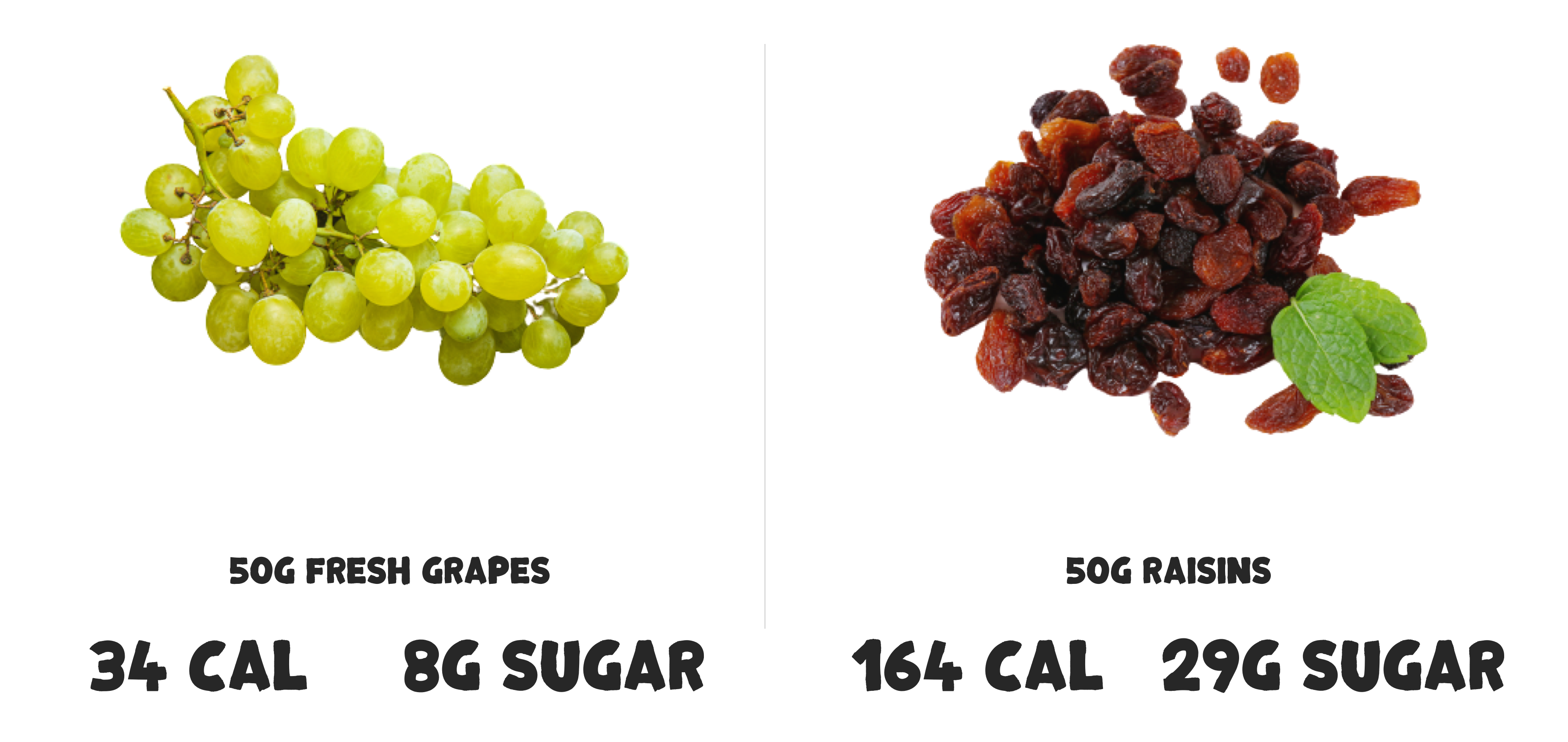
The short answer is YES! but it depends
Not all dried fruits are the same
Dried fruit is essentially fresh fruit with all the water sucked out. The term ‘Dried Fruit’ covers a range of different processing methods and while ‘Dried Fruit’ products such as Jungle Fruits may be good for you, not every dried fruit snack is the same.
So what are these magical processing methods you speak of?

Gently Dried Fruit
Gently drying fruit has been practised for hundreds of years; even the Romans & Egyptians did it dating back to at least 12,000 BC. The only difference now is that rather than placing the fruits under the sun, we use machines to do the drying.
Freeze Dried Fruit
The freeze drying process is relatively modern; this is where fruits are frozen and then placed in a vacuum under low pressures which cause solid ice to turn into water vapour removing all the water content.
Sugar Infused Dried Fruits
Sugar infused dried fruits are usually sweetened with fruit sugar solutions before drying. These candied dried fruits are unfortunately one of the worst forms of dried fruits you could eat from a health and wellbeing perspective. The process that goes into making these type of fruits involves boiling the fruits in water added with sugar.
Ok, so what’s the nutritional content like?
You can find up to 4 times more fibre, vitamins and minerals in dried fruits as opposed to fresh fruits. Naturally, when fruits are dried they shrink in size; this is especially true for gently dried fruits. All great things come in small sizes and the same is true for dried fruit. Dried fruits are nutrient-dense which means the smaller dried versions of the larger fresh fruits pack loads of vitamins, antioxidants and fibre as they are concentrated.
The vitamins and minerals we get depend on which fruits we consume which is why it is important to vary our diets and the types of fruits we eat so that our bodies receive all the good stuff it needs to function properly. They also provide healthier solutions to other snacks such as chocolate bars and pesky potato chips.
Since dried fruits are packed with all the good stuff it provides us with a convenient way of achieving the recommended 5 a day fruit and veg intake. Only a small amount of dried fruits are needed to reach the 30g/day fibre recommendation. This recommended intake of fibre is associated with a decreased risk of diseases such as type 2 diabetes, colorectal cancer and coronary heart disease (SACN, 2015). The advice is to consume both fresh fruits and dried fruits for a healthier diet.
You should be aware that studies have found that when water is removed from fruits water-soluble vitamins are also lost. What this means in layman's terms is that both gently dried and freeze dried fruits ,unfortunately, lose vitamin C during the drying process however as mentioned earlier dried fruits still many many other essential vitamins and minerals.
So, I am hearing all the good stuff but what about the bad?
We said that when it comes to dried fruits it’s not bad for you dependent on a few conditions. Where it turns bad is when dried fruits are treated with preservatives such as sulphur dioxide and added with sugar.
Sulphur Dioxide (S02) is commonly used in dried fruits as they allow the fruits to retain their colour instead of the fruits having their natural looks. Now where a bit of confusion comes for everyday people is around the word ‘Sulphur’. On one hand, Sulphur is a pure element which is found in the earth’s crust and is a very beneficial mineral. On the other hand ‘Sulphur Dioxide (S02) is a gaseous compound which is created by burning oil or coal and is often used in food production as a bleaching agent, disinfectant and preservative. Although small amounts of Sulphur Dioxide is not harmful to our body, regularly consuming dried fruits containing this agent is not a good idea. It has been reported that sulphur dioxide has lead to asthma-like reactions amongst some people sensitive to sulphates.
Other dried fruit brands are coated in refined vegetable oil to reduce the chances of the pieces sticking together. Now if the ingredients used were healthy fats such as avocado oils and extra virgin olive oils it would not be a problem. What you want to avoid are brands that use soy or canola oils with their dried fruits as this increases the likelihood of them being genetically modified crops.
Lastly, some dried fruit brands add extra sugar to their already naturally sweetened fruits. There are several reasons why some dried fruit snacks decide to add sugar to their fruits including increasing shelf life as the sugar reduces the water activity within the fruits (Goldfein and Slavin, 2015). Also when we eat dried fruits with added sugar we increase the risk of having an addictive overeating response.
Always make sure you check the ingredients to understand what you’re eating. There has been a massive shift and awareness towards naturally dried fruits free from added sugars and preservatives and snack companies like Jungle Fruits are leading the way in this.
How satisfying are dried fruits
There are two things to think about when comparing fresh fruit and dried fruit; volume and water content. Not to bore you too much with the science but essentially these two things are really important for the release of satiety hormones which essentially stops our appetite and fills our stomach up. As we have mentioned earlier because gently dried fruits shrink in size not only are all the good nutrients concentrated but the taste is also richer meaning they are very tasty. Freeze dried fruits maintain their fruit shapes so although they may not be as sweet as Gently Dried Fruits they are bigger in size. Dried fruits contain less water and small portion sizes may not fill some of our stomachs up as much as fresh fruits and because they are very tasty many of us can end up eating loads in one go. Think about how easy it would be to eat 50g of raisins in comparison to 50g of grapes. One suggestion around eating dried fruit is to consume these with water to increase the volume within the stomach.

Not all sugars are created equal
Sugar is often labelled under one umbrella which is why there is confusion around whether dried fruits are healthy or not. There is no doubt that extra sugars also means extra calories which increase your risk for various conditions such as diabetes and high blood pressure. However, a distinction needs to be made between what the nutritional world would label as ‘Free Sugars or Added Sugars’ and ‘Naturally Occurring Sugars’.
FDA classifies added free sugars as, “sugars and syrups that are added to foods during processing” excluding sugars naturally found in foods, such as fruits or dairy products (Erickson and Slavin, 2015).
Naturally occurring sugars ,on the other hand, are found in fruits including dried fruit, vegetables and milk. These do not harm our health and in fact, contain concentrated nutrients such as fibre.
Total sugars are the combination of ‘Naturally Occurring Sugars’ and ‘Added Free Sugars’.
If we want to avoid those extra calories and the bad things associated with sugars it’s the ‘Free Added Sugars’ that we want to watch out for and limit.

Check out this video from our friends at the British Heart Foundation which explains the difference in sugars.
Interestingly when fresh fruits are turned into fruit juice the sugars come out of their cells (sorry for the science again) making them free sugars.
The majority of the population within the UK are eating twice as much free sugars as the recommended free sugar intake. These usually come from the sugars we add to foods and drinks including those mischievous chocolate spreads and cakes.
Adults and children should not consume more than 30g of free sugars a day

If you have ever looked at food labels you may have noticed that sometimes sugar is just labelled as Total Sugars. This makes it difficult for us to figure out which snacks contain the sugars we ought to be reducing like added sugars and which sugars are not bad for us like natural sugars. A push has been made towards governments to allow consumers to differentiate between these sugars and as of 2016, the FDA has advised companies to distinguish between the two which allows us to make better-informed decisions around what we eat.
“Dried fruit is chock full of vitamins, minerals, fibre, and phytochemicals. Plus, it’s non-perishable, palatable, and great for eating on the run,”
Laura Hartung, registered dietitian nutritionist
Overall

Dried fruits which are natural with no added sugars or preservatives are low in fat, high in fibre and concentrated with micronutrients. Nothing beats fresh fruits however dried fruits provide a convenient way to eat fruit especially the exotic kind. It leaves no messy peelings, packs all the nutrients, tastes just as nice and has a long shelf life.
Due to the portion sizes being generally smaller with dried fruits in comparison to fresh fruits it also helps consumers attain a higher overall intake of fruit. Dried fruit should not be seen as a replacement of fresh fruit but rather eaten in addition to fresh fruit. Due to the lower weight of dried fruit per portion, it’s much easier to eat two portions of dried mangos than to eat two portions of whole fresh mangos which means it increases the ability to consume all the good nutrients at a lower volume.
Dried fruits are good for you but like anything too many calories even of healthy foods can lead to weight gain but we have the choice between healthy calories or unhealthy empty calories.
Bottom line
Eat more fruit every day in the least processed way which is ideally fresh. If you find yourself in situations where you can’t eat fresh fruits then eat the closest thing to this which is naturally dried fruits.
Come and get the taste our the jungle with our exotic range of dried fruits today.
#Tasteofthejungle
References
Erickson, J. and Slavin, J., 2015. Total, Added, and Free Sugars: Are Restrictive Guidelines Science-Based or Achievable?. Nutrients, 7(4), pp.2866–2878.
Goldfein, K. and Slavin, J., 2015. Why Sugar Is Added to Food: Food Science 101. Comprehensive Reviews in Food Science and Food Safety, 14(5), pp.644–656.
[SACN] Scientific Advisory Committee on Nutrition, 2015. Carbohydrates And Health.. [online] Public Health England. Available at: <https://www.gov.uk/government/publications/sacn-carbohydrates-and-health-report> [Accessed 2 April 2020].









